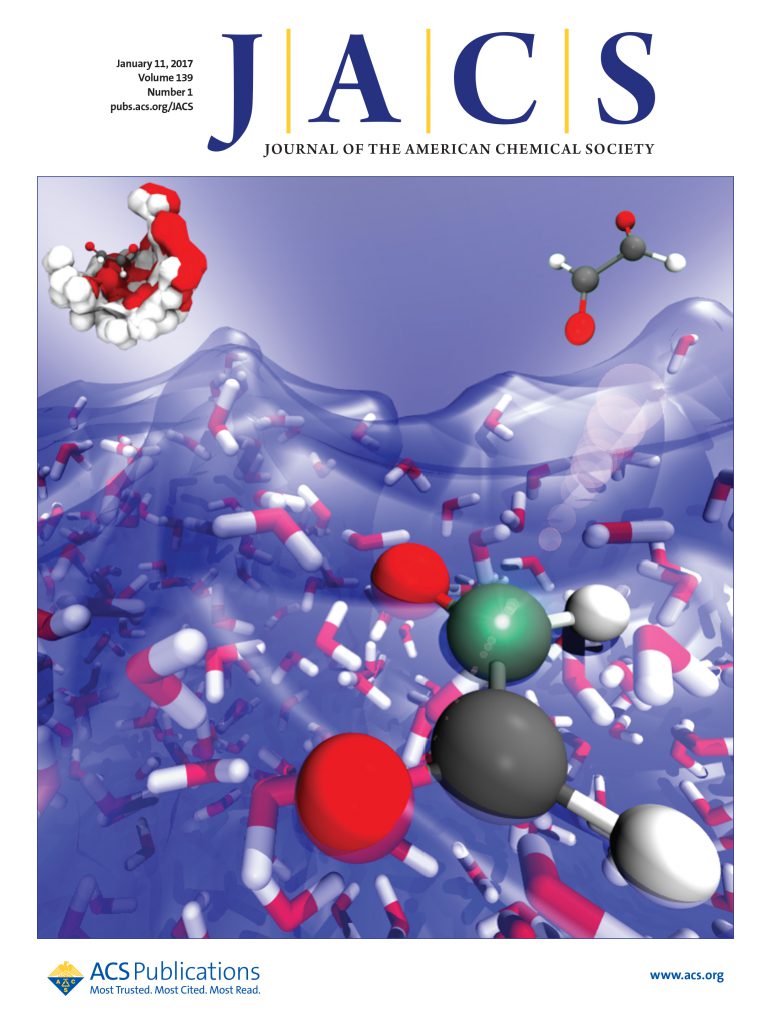Monolayered Metal-Organic Framework Unlocks Integration of Shaped Nanoparticles for Synergistic Photocatalysis.
IF 14.4
1区 化学
Q1 CHEMISTRY, MULTIDISCIPLINARY
引用次数: 0
Abstract
Metal-organic frameworks (MOFs) with ordered structures and high surface areas are promising supports for metal nanoparticles (MNPs) in synergistic catalysis. However, their limited pore sizes restrict integration to small spherical MNPs, excluding shaped MNPs that are critical for exposing specific lattice surfaces and achieving a superior catalytic performance. In this work, we address this limitation by reducing MOFs to monolayers, enabling the integration of shaped MNPs onto their surfaces to significantly enhance the catalytic efficiency. The monolayered MOF (monoMOF), Hf12-Ir, with a thickness of ∼1.8 nm, was synthesized using photosensitizing DBB-Ir-F linkers. Freshly synthesized cubic Cu nanoparticles (Cu-NPs, ∼35 nm) were functionalized with thioctic acid (TA) via Cu-S coordination and integrated onto the surface of Hf12-Ir through carboxylate-Hf12 coordination, forming the Cu/Hf12-Ir composite. Upon light irradiation, Cu/Hf12-Ir achieved exceptional CO2-to-CO conversion with a turnover frequency of 82.9 mmol gCu-1 h-1 and a CO selectivity of 98.3%. This catalytic performance was over an order of magnitude higher than that of the homogeneous system (Cu-NPs and H2DBB-Ir-F) and the small spherical MNPs-based composite (S-Cu/Hf12-Ir). Mechanistic studies revealed a synergistic effect between the Cu-NPs and Hf12-Ir, where their proximity enhanced electron transfer from the photoexcited DBB-Ir-F centers to the Cu-NPs. This work demonstrates a straightforward strategy for constructing MNP-monoMOF composites and highlights the critical charge transfer pathway between the photosensitizing monoMOF and catalytic MNPs.单层金属-有机框架解锁一体化的形状纳米颗粒的协同光催化。
具有有序结构和高比表面积的金属有机骨架(MOFs)是金属纳米颗粒(MNPs)协同催化的良好载体。然而,它们有限的孔径限制了集成到小的球形MNPs,不包括对于暴露特定晶格表面和实现卓越催化性能至关重要的形状MNPs。在这项工作中,我们通过将mof减少到单层来解决这一限制,使成型MNPs集成到其表面上,从而显着提高催化效率。利用光敏DBB-Ir-F连接剂合成了厚度约1.8 nm的单层MOF (monoMOF) Hf12-Ir。新合成的立方Cu纳米粒子(Cu- nps, ~ 35 nm)通过Cu- s配位被硫辛酸(TA)功能化,并通过羧酸- hf12配位集成到Hf12-Ir表面,形成Cu/Hf12-Ir复合材料。在光照射下,Cu/Hf12-Ir实现了出色的co2 -CO转化,转换频率为82.9 mmol gCu-1 h-1, CO选择性为98.3%。该催化性能比均相体系(Cu-NPs和H2DBB-Ir-F)和小球形mnps基复合材料(S-Cu/Hf12-Ir)的催化性能高一个数量级以上。机制研究揭示了Cu-NPs和Hf12-Ir之间的协同效应,其中它们的邻近增强了电子从光激发的DBB-Ir-F中心向Cu-NPs的转移。这项工作展示了一种构建MNP-monoMOF复合材料的直接策略,并强调了光敏性monoMOF和催化MNPs之间的关键电荷转移途径。
本文章由计算机程序翻译,如有差异,请以英文原文为准。
求助全文
约1分钟内获得全文
求助全文
来源期刊
CiteScore
24.40
自引率
6.00%
发文量
2398
审稿时长
1.6 months
期刊介绍:
The flagship journal of the American Chemical Society, known as the Journal of the American Chemical Society (JACS), has been a prestigious publication since its establishment in 1879. It holds a preeminent position in the field of chemistry and related interdisciplinary sciences. JACS is committed to disseminating cutting-edge research papers, covering a wide range of topics, and encompasses approximately 19,000 pages of Articles, Communications, and Perspectives annually. With a weekly publication frequency, JACS plays a vital role in advancing the field of chemistry by providing essential research.

 求助内容:
求助内容: 应助结果提醒方式:
应助结果提醒方式:


